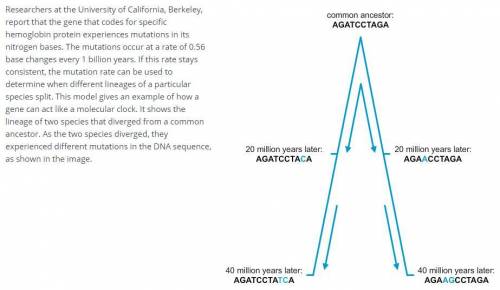
Biology, 25.04.2021 14:00 ashtonsilvers2003
Hello I really need help for this question, I don't understand what I am supposed to do! Thank you for help.
Molecular clock:
• Your timeline will span from 90 million years ago to the present. The common ancestor in your model is an arthropod that lived 90 million years ago. The gene that you’ll track codes for a protein in the species’ venom.
• The DNA sequence you’ll track contains 10 nitrogen bases. You can choose the order of the bases and where the mutations occur.
• This gene mutates at a rate of approximately 0.76 base pairs every 17.1 million years. To build your model, calculate the estimated time period it takes for 1 base pair to mutate.
• The first time period will only show the common ancestor. At the beginning of the second time period, three lineages will diverge from the common ancestor, each with a different mutation in their gene sequences.
• The first and third descendant species will survive for the rest of the timeline. The second descendant species was extinct 50 million years ago.
Question:
Using this sample model as a guide, create a molecular clock model. Use the flowchart tools in your word processing program to make your model. Make sure the mutations are clearly visible in the strand. Consider using a different font color for the mutations. Use the Insert Image button to insert a screenshot of your model in the answer space provided.


Answers: 1


Another question on Biology

Biology, 22.06.2019 09:30
Along what geographical feature are most of the oil producing regions located
Answers: 1


Biology, 22.06.2019 15:00
How do temperature and salinity affect deepwater currents? they create changes in wind direction, moving denser water in the same direction as the wind and causing the deepwater circulation patterns found in the ocean. as temperatures and salinity levels of water increase, the water rises to the surface where it creates currents as it moves to colder regions. they create density differences that cause dense deepwater currents to flow toward the equator where they displace less dense, warmer water above them. they equalize the forces on undersea currents caused by the coriolis effect as they replace more dense water with less dense water.
Answers: 1

Biology, 22.06.2019 15:10
Hairs that clean dirt out of the air in your nasal passages are called: a. sinus b. trachea c. cilia d. mucus
Answers: 2
You know the right answer?
Hello I really need help for this question, I don't understand what I am supposed to do! Thank you f...
Questions

History, 23.07.2019 14:00


Physics, 23.07.2019 14:00



Social Studies, 23.07.2019 14:00

Chemistry, 23.07.2019 14:00



Business, 23.07.2019 14:00

Mathematics, 23.07.2019 14:00


Biology, 23.07.2019 14:00


Social Studies, 23.07.2019 14:00

Biology, 23.07.2019 14:00

Biology, 23.07.2019 14:00


Spanish, 23.07.2019 14:00



